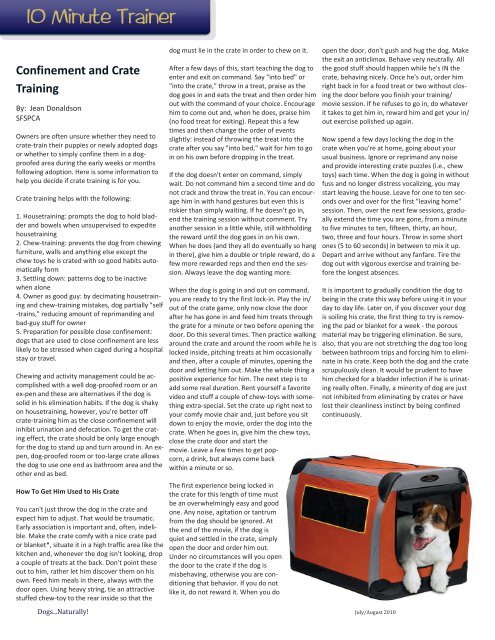July/August 2010 - Dogs Naturally Magazine
July/August 2010 - Dogs Naturally Magazine
July/August 2010 - Dogs Naturally Magazine
You also want an ePaper? Increase the reach of your titles
YUMPU automatically turns print PDFs into web optimized ePapers that Google loves.
Confinement and Crate<br />
Training<br />
By: Jean Donaldson<br />
SFSPCA<br />
Owners are often unsure whether they need to<br />
crate-train their puppies or newly adopted dogs<br />
or whether to simply confine them in a dogproofed<br />
area during the early weeks or months<br />
following adoption. Here is some information to<br />
help you decide if crate training is for you.<br />
Crate training helps with the following:<br />
1. Housetraining: prompts the dog to hold bladder<br />
and bowels when unsupervised to expedite<br />
housetraining<br />
2. Chew-training: prevents the dog from chewing<br />
furniture, walls and anything else except the<br />
chew toys he is crated with so good habits automatically<br />
form<br />
3. Settling down: patterns dog to be inactive<br />
when alone<br />
4. Owner as good guy: by decimating housetraining<br />
and chew-training mistakes, dog partially "self<br />
-trains," reducing amount of reprimanding and<br />
bad-guy stuff for owner<br />
5. Preparation for possible close confinement:<br />
dogs that are used to close confinement are less<br />
likely to be stressed when caged during a hospital<br />
stay or travel.<br />
Chewing and activity management could be accomplished<br />
with a well dog-proofed room or an<br />
ex-pen and these are alternatives if the dog is<br />
solid in his elimination habits. If the dog is shaky<br />
on housetraining, however, you're better off<br />
crate-training him as the close confinement will<br />
inhibit urination and defecation. To get the crating<br />
effect, the crate should be only large enough<br />
for the dog to stand up and turn around in. An expen,<br />
dog-proofed room or too-large crate allows<br />
the dog to use one end as bathroom area and the<br />
other end as bed.<br />
How To Get Him Used to His Crate<br />
You can't just throw the dog in the crate and<br />
expect him to adjust. That would be traumatic.<br />
Early association is important and, often, indelible.<br />
Make the crate comfy with a nice crate pad<br />
or blanket*, situate it in a high traffic area like the<br />
kitchen and, whenever the dog isn't looking, drop<br />
a couple of treats at the back. Don't point these<br />
out to him, rather let him discover them on his<br />
own. Feed him meals in there, always with the<br />
door open. Using heavy string, tie an attractive<br />
stuffed chew-toy to the rear inside so that the<br />
dog must lie in the crate in order to chew on it.<br />
After a few days of this, start teaching the dog to<br />
enter and exit on command. Say "into bed" or<br />
"into the crate," throw in a treat, praise as the<br />
dog goes in and eats the treat and then order him<br />
out with the command of your choice. Encourage<br />
him to come out and, when he does, praise him<br />
(no food treat for exiting). Repeat this a few<br />
times and then change the order of events<br />
slightly: instead of throwing the treat into the<br />
crate after you say "into bed," wait for him to go<br />
in on his own before dropping in the treat.<br />
If the dog doesn't enter on command, simply<br />
wait. Do not command him a second time and do<br />
not crack and throw the treat in. You can encourage<br />
him in with hand gestures but even this is<br />
riskier than simply waiting. If he doesn't go in,<br />
end the training session without comment. Try<br />
another session in a little while, still withholding<br />
the reward until the dog goes in on his own.<br />
When he does (and they all do eventually so hang<br />
in there), give him a double or triple reward, do a<br />
few more rewarded reps and then end the session.<br />
Always leave the dog wanting more.<br />
When the dog is going in and out on command,<br />
you are ready to try the first lock-in. Play the in/<br />
out of the crate game, only now close the door<br />
after he has gone in and feed him treats through<br />
the grate for a minute or two before opening the<br />
door. Do this several times. Then practice walking<br />
around the crate and around the room while he is<br />
locked inside, pitching treats at him occasionally<br />
and then, after a couple of minutes, opening the<br />
door and letting him out. Make the whole thing a<br />
positive experience for him. The next step is to<br />
add some real duration. Rent yourself a favorite<br />
video and stuff a couple of chew-toys with something<br />
extra-special. Set the crate up right next to<br />
your comfy movie chair and, just before you sit<br />
down to enjoy the movie, order the dog into the<br />
crate. When he goes in, give him the chew toys,<br />
close the crate door and start the<br />
movie. Leave a few times to get popcorn,<br />
a drink, but always come back<br />
within a minute or so.<br />
The first experience being locked in<br />
the crate for this length of time must<br />
be an overwhelmingly easy and good<br />
one. Any noise, agitation or tantrum<br />
from the dog should be ignored. At<br />
the end of the movie, if the dog is<br />
quiet and settled in the crate, simply<br />
open the door and order him out.<br />
Under no circumstances will you open<br />
the door to the crate if the dog is<br />
misbehaving, otherwise you are conditioning<br />
that behavior. If you do not<br />
like it, do not reward it. When you do<br />
open the door, don't gush and hug the dog. Make<br />
the exit an anticlimax. Behave very neutrally. All<br />
the good stuff should happen while he's IN the<br />
crate, behaving nicely. Once he's out, order him<br />
right back in for a food treat or two without closing<br />
the door before you finish your training/<br />
movie session. If he refuses to go in, do whatever<br />
it takes to get him in, reward him and get your in/<br />
out exercise polished up again.<br />
Now spend a few days locking the dog in the<br />
crate when you're at home, going about your<br />
usual business. Ignore or reprimand any noise<br />
and provide interesting crate puzzles (i.e., chew<br />
toys) each time. When the dog is going in without<br />
fuss and no longer distress vocalizing, you may<br />
start leaving the house. Leave for one to ten seconds<br />
over and over for the first "leaving home"<br />
session. Then, over the next few sessions, gradually<br />
extend the time you are gone, from a minute<br />
to five minutes to ten, fifteen, thirty, an hour,<br />
two, three and four hours. Throw in some short<br />
ones (5 to 60 seconds) in between to mix it up.<br />
Depart and arrive without any fanfare. Tire the<br />
dog out with vigorous exercise and training before<br />
the longest absences.<br />
It is important to gradually condition the dog to<br />
being in the crate this way before using it in your<br />
day to day life. Later on, if you discover your dog<br />
is soiling his crate, the first thing to try is removing<br />
the pad or blanket for a week - the porous<br />
material may be triggering elimination. Be sure,<br />
also, that you are not stretching the dog too long<br />
between bathroom trips and forcing him to eliminate<br />
in his crate. Keep both the dog and the crate<br />
scrupulously clean. It would be prudent to have<br />
him checked for a bladder infection if he is urinating<br />
really often. Finally, a minority of dog are just<br />
not inhibited from eliminating by crates or have<br />
lost their cleanliness instinct by being confined<br />
continuously.<br />
<strong>Dogs</strong>...<strong>Naturally</strong>! <strong>July</strong>/<strong>August</strong> <strong>2010</strong>












